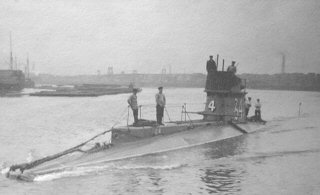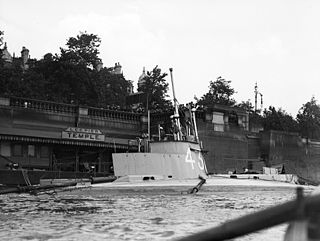HMS A2 was an A-class submarine built for the Royal Navy in the first decade of the 20th century.

HMS A6 was an A-class submarine built for the Royal Navy in the first decade of the 20th century.
HMS A12 was an A-class submarine built for the Royal Navy in the first decade of the 20th century. After surviving World War I, she was sold for scrap in 1920.

HMS A10 was an A-class submarine built for the Royal Navy in the first decade of the 20th century. After surviving World War I, she was sold for scrap in 1919.

HMS C3 was one of 38 C-class submarines built for the Royal Navy in the first decade of the 20th century. The boat was used to demolish a viaduct during the Zeebrugge Raid in 1918.

HMS C4 was one of 38 C-class submarines built for the Royal Navy in the first decade of the 20th century. The boat survived the First World War and was sold for scrap in 1922.

HMS C12 was one of 38 C-class submarines built for the Royal Navy in the first decade of the 20th century. The boat survived the First World War and was sold for scrap in 1920.

HMS C13 was one of 38 C-class submarines built for the Royal Navy in the first decade of the 20th century. The boat survived the First World War and was sold for scrap in 1920.

HMS C14 was one of 38 C-class submarines built for the Royal Navy in the first decade of the 20th century. The boat survived the First World War and was sold for scrap in 1921.

HMS C15 was one of 38 C-class submarines built for the Royal Navy in the first decade of the 20th century. The boat survived the First World War and was sold for scrap in 1922.
HMS C20 was one of 38 C-class submarines built for the Royal Navy in the first decade of the 20th century. The boat survived the First World War and was sold for scrap in 1921.
HMS C24 was one of 38 C-class submarines built for the Royal Navy in the first decade of the 20th century. The boat survived the First World War and was sold for scrap in 1921.
HMS C26 was one of 38 C-class submarines built for the Royal Navy in the first decade of the 20th century.

HMS C38 was one of 38 C-class submarines built for the Royal Navy in the first decade of the 20th century. The boat survived the First World War and was sold for scrap in 1919.

HMS C37 was one of 38 C-class submarines built for the Royal Navy in the first decade of the 20th century. The boat survived the First World War and was sold for scrap in 1919.

HMS C36 was one of 38 C-class submarines built for the Royal Navy in the first decade of the 20th century. The boat survived the First World War and was sold for scrap in 1919.

HMS C31 was one of 38 C-class submarines built for the Royal Navy in the first decade of the 20th century. She struck a mine in 1915 and sank with the loss of all hands.
HMS C30 was one of 38 C-class submarines built for the Royal Navy in the first decade of the 20th century. The boat survived the First World War and was sold for scrap in 1921.
HMS C32 was one of 38 C-class submarines built for the Royal Navy in the first decade of the 20th century. The boat ran aground in the Baltic in 1917 and had to be destroyed to prevent her capture.
HMS L23 was a L-class submarine built for the Royal Navy during World War I. The boat was not completed before the end of the war and was one of the three L-class boats to serve during World War II. L23 was sold for scrap in 1946.












